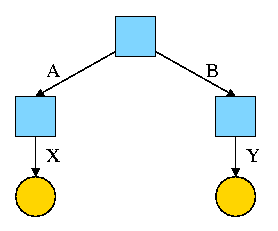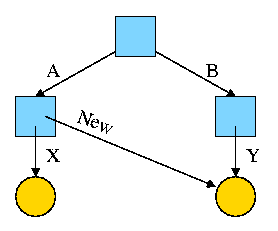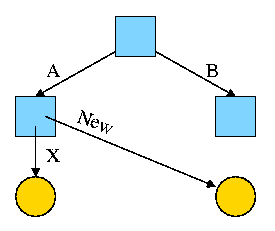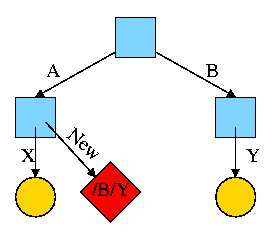
Note:Some confusion may have arisen. Working together on a lab is ok. But you are to write the labs yourselves. So the labs should look substantially different as one would expect when two people write up ideas they worked on together.

Start with an empty file system (i.e., just the root directory) and then execute:
cd / mkdir /A; mkdir /B touch /A/X; touch /B/Y
We have the situation shown on the right.
Note that names are on edges not nodes.
When there are no multinamed files, it doesn't much matter.

Now execute
ln /B/Y /A/NewThis gives the new diagram to the right.
At this point there are two equally valid name for the right hand yellow file, /B/Y and /A/New. The fact that /B/Y was created first is NOT detectable.

Assume Bob created /B and /B/Y and Alice created /A, /A/X, and /A/New. Later Bob tires of /B/Y and removes it by executing
rm /B/Y
The file /A/New is still fine (see third diagram on the right).
But it is owned by Bob, who can't find it! If the system enforces
quotas bob will likely be charged (as the owner), but he can neither
find nor delete the file (since bob cannot unlink, i.e. remove, files
from /A)
Since hard links are only permitted to files (not directories) the resulting file system is a dag (directed acyclic graph). That is, there are no directed cycles. We will now proceed to give away this useful property by studying symlinks, which can point to directories.

Again start with an empty file system and this time execute
cd / mkdir /A; mkdir /B touch /A/X; touch /B/Y ln -s /B/Y /A/New
We now have an additional file /A/New, which is a symlink to /B/Y.
The bottom line is that, with a hard link, a new name is created that has equal status to the original name. This can cause some surprises (e.g., you create a link but I own the file). With a symbolic link a new file is created (owned by the creator naturally) that points to the original file.
Question: Consider the hard link setup above. If Bob removes /B/Y
and then creates another /B/Y, what happens to /A/New?
Answer: Nothing. /A/New is still a file with the same contents as the
original /B/Y.
Question: What about with a symlink?
Answer: /A/New becomes invalid and then valid again, this time pointing
to the new /B/Y.
(It can't point to the old /B/Y as that is completely gone.)